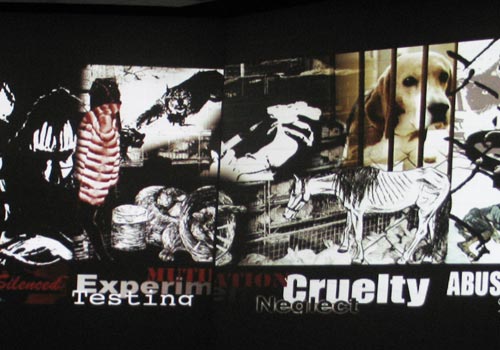Project explores notion of academic space
Students in Stephanie Cole’s Foundation classes explored themes of The World of Conflict. Cole will present the boundary-exploring project at a conference in Dublin this month. Images in the above detail were created by Valerie Bizzaro, Kristina Brugnoni and Chelsea Tyler.
A yearlong student project that explored “The World of Conflict” through an interdisciplinary, multimedia collage will be showcased later this month at an international conference about the changing notions of space in academia.
The conference, Defining Space, will be held at University College Dublin Oct. 11-13 and will explore space from different perspectives.
Artist Stephanie Kirschen Cole will share insights and a video about the project that began in her 2D Design Foundation classes in the College of Imaging Arts and Sciences last year and expanded to include poetry students from the College of Liberal Arts and faculty from the College of Science.
Cole is one of four interdisciplinary panelists sponsored by the Caroline Werner Gannett Project who will attend the conference as part of the panel “Moving Out/There: Strategies for Re-imagining Academic Spaces,” organized by Mary Lynn Broe, Caroline Werner Gannett Professor of Humanities. In addition to Cole and Broe, the panel will include Guy Johnson, director of the Center for Advancing the Study of Cyber Infrastructure in the B. Thomas Golisano College of Computing and Information Sciences, and Karen Kinslow, a graduate student in human geography at the University of Kentucky.
The World of Conflict project involved 60 first-year students from Cole’s Foundation classes who explored issues involving the environment, big business, war, sex, drugs and music, domestic abuse and animal cruelty.
The students created a five-part, panoramic multi-projection show that included narration, poetry, collage and animation and was projected in motion, 10 feet by 75 feet, across the College of Science auditorium wall last spring. The collage includes 55 different compositions and measures 80 feet long.
Students from English professor John Roche’s poetry classes wrote poetry for the project. Roche and Broe also contributed original poetry. College of Science Dean Ian Gatley helped facilitate the project, and Tim Stephaney and Mitch Rosen from the College of Science provided technical expertise on using Watchout technology and the corresponding multiple projection software Dataton.
“This project illustrates the notion of an expansive classroom that works on multiple collaborative and interdisciplinary levels from the individual classroom to the whole university,” Cole says. “In the process there was a shifting sense of classroom space.
Students felt connected to RIT as a whole university as well as connected to the global community as a world classroom.”














